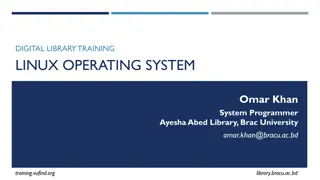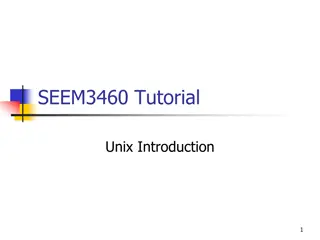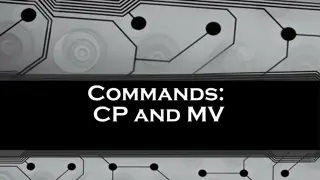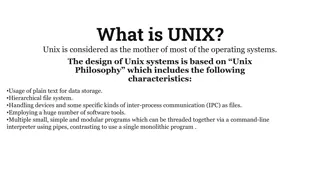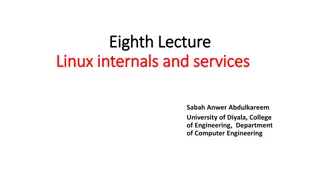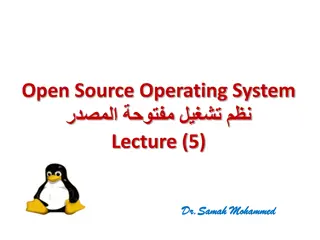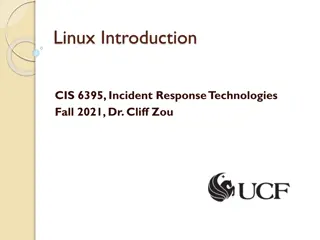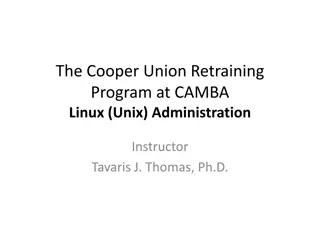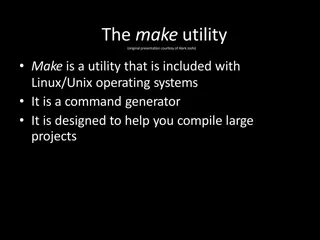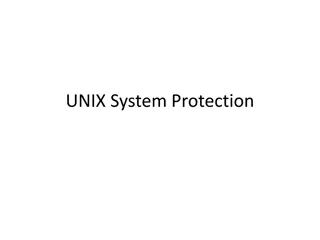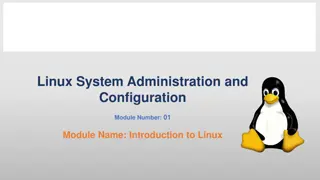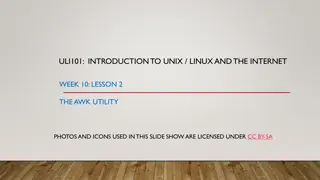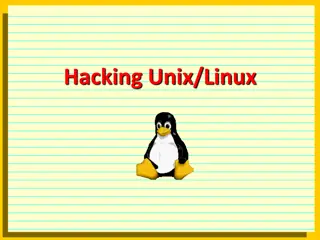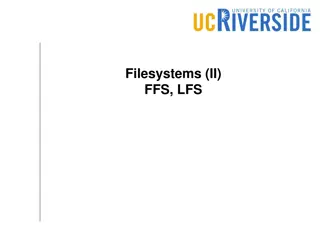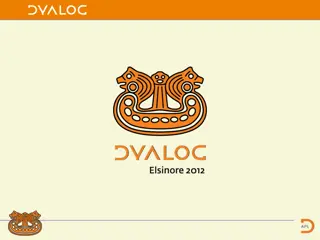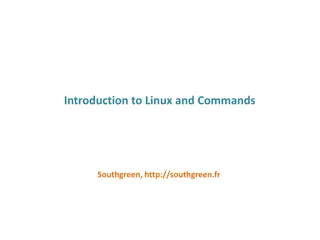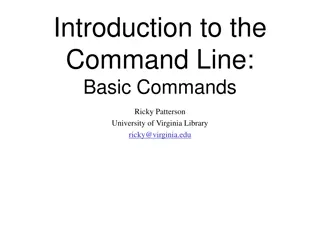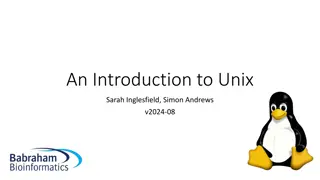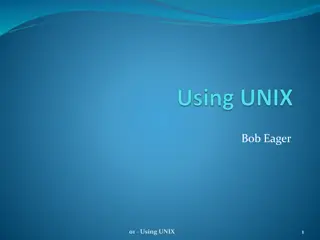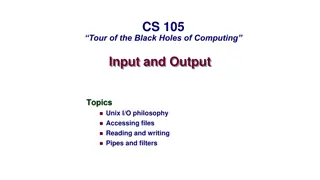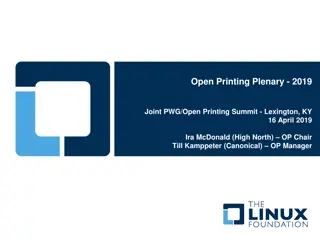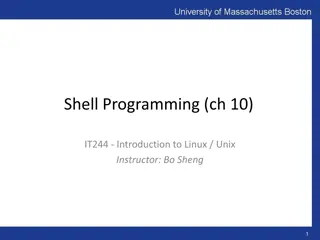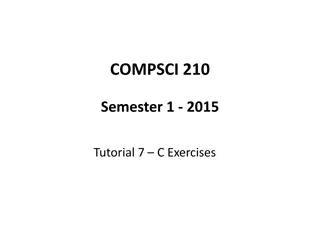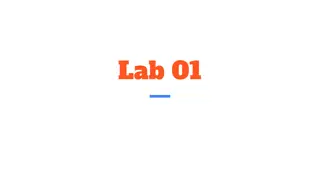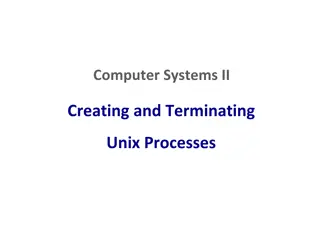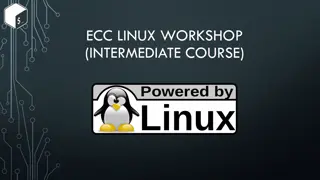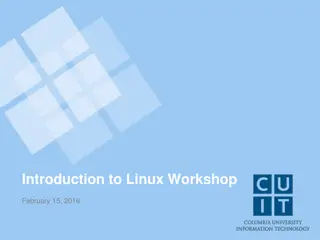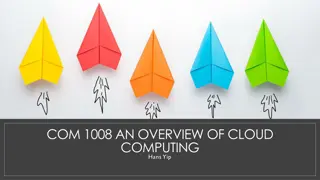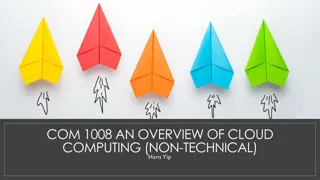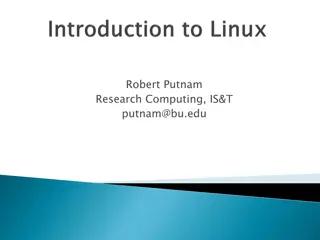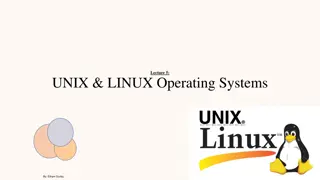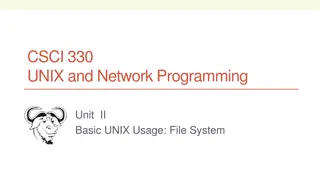Introduction to Bash Shell Programming
Learn about the fundamentals of shell programming in Unix/Linux systems, including the role of the shell as an interface between users and the operating system. Understand the components of a shell, such as the kernel, and explore different types of shells like Bourne Shell and C Shell. Discover how
6 views • 17 slides
Introduction to Linux Shell for CSE 374 Course
Explore the Linux shell basics in CSE 374 course, covering topics like using Bash shell, executing commands, connecting to remote Linux servers, and interaction basics such as navigating command history. Get ready to dive into text-based interfaces and command-line operations in a Unix environment.
0 views • 14 slides
Linux Course Overview and Content for Digital Library Training
Explore the world of Linux operating systems in the context of digital library training, covering topics such as Linux distributions, system administration, text manipulation, file systems, and network configuration. The course provides a comprehensive overview and detailed content modules to develo
1 views • 11 slides
Introduction to Unix-like Systems and Shell Interaction
Unix-like systems, such as Linux, Android, iOS, and macOS, are prevalent in various devices. The Unix shell acts as an intermediary between users and the operating system, allowing for program execution and process management. Secure Shell (SSH) and X Window System enable remote machine connections
4 views • 19 slides
Understanding CP and MV Commands in Unix/Linux
CP and MV commands in Unix/Linux are essential for copying and moving files or directories. CP is used to copy files with various options for different scenarios, while MV is used to move or rename files. Learn examples and practical usage of these commands to efficiently manage your files on the te
0 views • 5 slides
Understanding UNIX and Linux Operating Systems
UNIX, known as the mother of most operating systems, follows a design philosophy rooted in plain text data storage, hierarchical file systems, and modular programs. The UNIX kernel controls system functions, while Linux, a Unix-like OS, operates as a free and open-source alternative developed from s
2 views • 4 slides
Understanding Linux Services and Internals
Explore the components of a Linux system, including hardware controllers, the Linux kernel, operating system services, user applications, directory structure, shells, and essential Linux services. Learn how to list services in Linux by connecting via SSH and accessing them as a root user to manage c
1 views • 14 slides
Introduction to Linux Shell Scripting
Dive into the world of Linux shell scripting with a focus on the bash shell. Explore the basics of programming versus scripting, different shells available in Linux, common scripting errors, and the essential elements of writing shell scripts in Linux.
0 views • 26 slides
Introduction to Linux System Administration
Explore the essentials of Linux system administration in this course material. Learn how to access Linux servers and virtual machines, utilize SSH for secure connections, and configure Kali Linux VM settings for efficient usage. Gain hands-on experience with graphical and command-line interfaces to
0 views • 45 slides
Linux Administration Essentials: A Comprehensive Training Program
Join the Cooper Union Retraining Program at CAMBA for an intensive course on Linux (Unix) Administration instructed by Dr. Tavaris J. Thomas. Learn core objectives spanning from file system management to network configuration without diving into hacking or programming. Explore the history of Linux,
0 views • 35 slides
Understanding the Make Utility in Linux/Unix Operating Systems
The Make utility in Linux/Unix is a command generator designed to assist in compiling large projects efficiently by using Makefiles with rules and dependencies to determine and execute necessary tasks. It minimizes recompilation, reduces resource usage, and streamlines complex program compilation pr
0 views • 21 slides
Overview of UNIX System Protection
UNIX System Protection focuses on ensuring security and access control mechanisms within the UNIX operating system. Developed in 1969 by Dennis Ritchie and Ken Thompson at AT&T Bell Labs, UNIX features design elements like a portable API, protection rings, kernel processes, and a trusted computing b
0 views • 12 slides
Overview of the Linux Boot Process
Exploring the six stages of the Linux boot process, starting from the BIOS and Master Boot Record (MBR) to the Grand Unified Bootloader (GRUB) and kernel initialization. Understand the essential components involved in booting up a Linux system, from system integrity checks to mounting the root file
0 views • 18 slides
Introduction to Linux System Administration
Explore the fundamentals of Linux system administration, including accessing Linux systems, using SSH for secure connections, setting up virtual machines, understanding the Unix system kernel and shell, and grasping the multi-user and multi-process aspects of Unix. Enhance your skills in managing Li
0 views • 42 slides
CS252 Systems Programming Course Overview
This course overview covers topics such as C programming review, Unix basics, Unix systems programming, and grading details. The course includes labs on C/C++ programming, Unix shell scripting, and writing your own shell. Communication is emphasized through Piazza for questions/answers and Blackboar
0 views • 41 slides
Understanding the AWK Utility in Unix/Linux
The AWK utility in Unix/Linux is primarily used for pattern scanning and processing. It searches files for specified patterns and executes associated actions. It functions by reading input files, applying selection criteria within quotes, and executing actions within braces based on matched criteria
0 views • 21 slides
Understanding Unix/Linux Hacking Techniques
Explore Unix/Linux hacking techniques including footprinting, scanning, enumeration, vulnerability mapping, remote access, data-driven attacks, buffer overflow, input validation, and countermeasures. Discover methods to gain root access, exploit vulnerabilities, perform brute force attacks, and secu
0 views • 6 slides
Understanding Filesystems and Inodes in UNIX
Delve into the complexities of filesystems such as FFS and LFS, exploring concepts like i-nodes, ownership, permissions, and indirect blocks. Learn about the structure of UNIX inodes, path searching, caching, read-ahead optimization, and the limitations of the original UNIX filesystem. Unravel the i
0 views • 24 slides
Dyalog APL on UNIX - Development Environment Overview
Discover the supported platforms for Dyalog APL on UNIX, including AIX and various Linux distributions. Learn about driving APL on UNIX, using PuTTY for Windows clients, configuring terminal windows, and running TryAPL as a service. Get insights on setting up Dyalog APL on Linux and explore keyboard
1 views • 39 slides
Introduction to Linux and Commands - Overview and Benefits
Linux is a powerful operating system with roots in UNIX, offering a wide array of functionalities for users. The program goals include presenting the Linux OS basics, introducing fundamental command-line operations, and showcasing the utilization of bioinformatics software. The content explores the
0 views • 79 slides
Introduction to the Command Line: Basic Commands and Unix Systems
This material provides an overview of fundamental commands in Unix systems, applicable to both Unix and Linux operating systems. It covers topics like directory structure, text file manipulation, file permissions, redirections, pipes, wildcards, and more. Learn about the nature of Unix systems, how
0 views • 43 slides
Understanding Unix: Fundamentals and Connections
Explore the basics of Unix operating systems, terminology, types of Linux installations, and connecting to remote Linux machines. Learn about key concepts such as local vs. remote connections, SSH connections using passwords and keys, and tools like PuTTY for remote access.
0 views • 78 slides
Introduction to Using UNIX: A Comprehensive Guide
Explore the rich history and practical benefits of using UNIX systems. Learn about the UNIX user interface, the significance of command line interactions, the philosophy of small programs, and the evolution of graphical interfaces. Discover why mastering UNIX skills is valuable for computing student
0 views • 29 slides
Understanding UNIX Operating System
UNIX is a versatile operating system that enables multi-user access, multitasking, and portability across various computing environments. It serves as the foundation for many modern operating systems and has influenced concepts incorporated in Microsoft Windows and DOS. The UNIX system comprises dis
0 views • 51 slides
Exploring Unix Input and Output Topics in CS.105
Dive into the Unix I/O philosophy, understanding pathnames, conventions, and file structures. Learn how Unix revolutionized file handling with its unified approach and discover the power of accessing files, reading/writing, pipes, and filters. Gain insights into Unix file conventions and the flexibi
0 views • 29 slides
Introduction to Linux: Course Overview and Objectives
This introduction to Linux course provides a comprehensive overview of operating systems, including the history, variations, user interface, and essential commands. The course is designed with lectures, labs, and exercises to help participants gain a better understanding of Linux and its practical a
0 views • 77 slides
Linux Printing Technologies Overview
Delve into the world of Linux printing with insights on open printing plenary sessions, Linux distribution market shares, driverless printing support, CUPS filters development, and future trends. Explore the growing popularity of Linux in various sectors and witness the advancements in driverless pr
0 views • 13 slides
Introduction to Shell Programming in Linux/Unix with Vim and Control Flow Commands
Explore the basics of shell programming in Linux/Unix, including Vim commands for editing files, control flow commands like if-then statements, and examples of executing commands with built-in utilities. Learn how to handle arguments, read input, and implement conditional logic in scripts.
0 views • 47 slides
Introduction to UNIX Commands and Basic C Programming Exercises
This content guide provides step-by-step instructions on downloading, unpacking, and using examples in UNIX environment, connecting to a university UNIX account from Windows using Putty, logging in with UPI and password, and running basic C programming exercises. It also covers basic Linux commands
0 views • 13 slides
Understanding UNIX Operating System and File System
UNIX is a powerful operating system developed in the 1960s that forms the basis for modern systems like Linux. It manages hardware communication for users and programs. The file system organizes files in a hierarchical structure, with directories acting as folders. Learn about directories, subdirect
0 views • 19 slides
Understanding Unix Process Management in Computer Systems II
This overview delves into the creation, termination, memory layout, and dynamic memory management of Unix processes in Computer Systems II. It covers the distinctions between code, executables, and processes, the memory layout of Unix processes, management of heap memory using malloc and free functi
0 views • 27 slides
Intermediate Linux Workshop Overview
This intermediate Linux workshop covers various topics including input, output, pipes, processes, compiling Unix software packages, symbolic and hard links, environment variables, security, and ECC policies. It also explains CougarNet authentication for accessing engineering Linux systems, setting u
0 views • 34 slides
Introduction to Linux Workshop and History: A Brief Overview
Delve into the world of Linux with an introduction to its basics, operating system functionalities, and a quick history lesson from the Unix roots to the release of Linux. Explore the significance of Linux as an operating system and the evolution of computing. Get insights into key milestones like U
0 views • 98 slides
Overview of Windows Subsystem for Linux 2 (WSL2)
Windows Subsystem for Linux 2 (WSL2) is a new feature in Windows 10 that enables users, especially developers, to run native Linux command-line tools directly on Windows alongside traditional desktop applications. WSL provides a way to use Bash, common Linux tools, and Linux-first tools on Windows,
0 views • 11 slides
Introduction to Linux: Key Aspects and Application in Robotics
Discover the significance of Linux in the world of robotics and beyond. Learn about its widespread usage, versatility under the GNU GPL license, robust security features, and practical application through executing bash scripts on a Linux system. Dive into the fundamentals of Linux Shell interaction
0 views • 21 slides
Overview of Windows Subsystem for Linux 2 (WSL)
Windows Subsystem for Linux 2 (WSL) is a new feature in Windows 10 that allows users to run native Linux command-line tools directly on Windows alongside traditional desktop and store apps. It is primarily geared towards developers, especially web developers and those working with open-source projec
0 views • 14 slides
Understanding Linux and Its Importance in Computing
Linux, a Unix clone developed by Linus Torvalds in 1991, is a widely used operating system powering servers, mobile phones, and other devices. It emphasizes the collaborative nature of software development and the synergies between different programs. This overview delves into key aspects of Linux,
0 views • 49 slides
Understanding Linux Virtual Memory Management
The memory management subsystem in Linux ensures fair physical memory allocation for running processes, allowing them to share virtual memory when needed. Processes can have separate virtual address spaces or share memory through mechanisms like Unix System V shared memory IPC. Linux uses an abstrac
0 views • 230 slides
Overview of UNIX and Linux Operating Systems
The UNIX brand encompasses a range of powerful multitasking, multiuser operating systems used by various organizations to develop IT technologies. UNIX internals consist of kernel space and user space, with programs accessing system services rather than hardware directly. The Unix filesystem is a ke
0 views • 36 slides
Introduction to Basic UNIX Usage and Network Programming
In this course, you will learn the fundamentals of UNIX usage and network programming. Topics covered include basic UNIX commands, file system structure, UNIX shell functionalities, command line structure, and essential commands like passwd, ls, more, logout, date, and man. Understanding the hierarc
0 views • 31 slides


